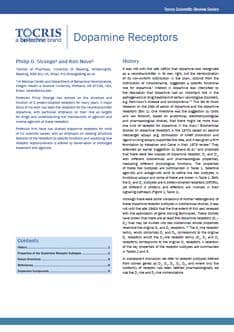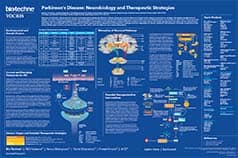D3 Receptors
D3 receptors are members of the dopamine receptor G-protein-coupled receptor family that also includes D1, D2, D4 and D5. They are located primarily in the nucleus accumbens, olfactory tubercle and island of Calleja where they are involved in the modulation of locomotion.
D3 Receptor Agonists |
|
|---|---|
| Cat. No. | 产品名称/活性 |
| 1243 | (+)-PD 128907 hydrochloride |
| High affinity D3 agonist (D3 ≥ D2 > D4) | |
| 4174 | Pramipexole dihydrochloride |
| Selective D3 agonist | |
| 3896 | Rotigotine hydrochloride |
| D2 and D3 agonist | |
D3 Receptor Antagonists |
|
| Cat. No. | 产品名称/活性 |
| 1847 | Eticlopride hydrochloride |
| D3 antagonist (D3 > D2) | |
| 2635 | NGB 2904 |
| Potent and selective D3 antagonist | |
| 3887 | PG 01037 dihydrochloride |
| Selective D3 antagonist | |
| 4207 | SB 277011A dihydrochloride |
| Selective D3 antagonist | |
D3 receptors are members of the dopamine receptor G-protein-coupled receptor family that also includes D1, D2, D4 and D5. They are located primarily in the nucleus accumbens, olfactory tubercle and island of Calleja where they are involved in the modulation of locomotion and have a possible role in cognition and emotion. The human D3 receptor gene has been localized to chromosome 3 (3q13.3).
External sources of pharmacological information for D3 Receptors :
Literature for D3 Receptors
Tocris offers the following scientific literature for D3 Receptors to showcase our products. We invite you to request* your copy today!
*Please note that Tocris will only send literature to established scientific business / institute addresses.
Dopamine Receptors Scientific Review
Written by Phillip Strange and revised by Kim Neve in 2013, this review summarizes the history of the dopamine receptors and provides an overview of individual receptor subtype properties, their distribution and identifies ligands which act at each receptor subtype. Compounds available from Tocris are listed.
Addiction Poster
The key feature of drug addiction is the inability to stop using a drug despite clear evidence of harm. This poster describes the brain circuits associated with addiction, and provides an overview of the main classes of addictive drugs and the neurotransmitter systems that they target.
Parkinson's Disease Poster
Parkinson's disease (PD) causes chronic disability and is the second most common neurodegenerative condition. This poster outlines the neurobiology of the disease, as well as highlighting current therapeutic treatments for symptomatic PD, and emerging therapeutic strategies to delay PD onset and progression.


